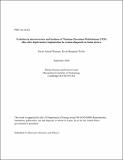| dc.contributor.author | Waseem, Owais Ahmed | en_US |
| dc.contributor.author | Woller, Kevin Benjamin | en_US |
| dc.date.accessioned | 2025-03-21T20:11:51Z | |
| dc.date.available | 2025-03-21T20:11:51Z | |
| dc.date.issued | 2020-09 | |
| dc.identifier | 20ja062 | |
| dc.identifier.uri | https://hdl.handle.net/1721.1/158566 | |
| dc.description | Submitted for publication in Materials Chemistry and Physics | |
| dc.description.abstract | A depth marker by ion implantation has been used for analysis of erosion on plasma-facing materials in fusion experiments. To assess the impact of ion implantation on the surface properties of these materials under investigation, Titanium-Zirconium-Molybdenum (TZM) alloy was irradiated with 4.8 MeV F3+ ions up to 1.04x1017 cm-2 at 330oC, achieving a depth marker centroid at ∼1.5 μm. After implantation, there is no significant change in microstructure and surface roughness under these implantation conditions, which were used for samples positioned on the high field side in the Experimental Advanced Superconducting Tokamak (EAST) device for erosion analysis. Nanoindentation measurements indicate an increase in hardness from ∼5.5 GPa to ∼6.6 GPa in the first 300 nm of the surface, within the eroded zone over a full years experimental campaign. Within 1.5 μm of the surface, where the damage from the ion beam is expected to be generated, the microstructure of implanted TZM shows a large number of dislocation lines (i.e. 1.0x109 dislocations/mm2), determined from TEM analysis, which can account for the increase in hardness of implanted TZM. These changes due to the ion implantation, though minor, should be considered when using ion implanted depth markers for erosion measurements of plasma-facing materials. | |
| dc.publisher | Elsevier | en_US |
| dc.relation.isversionof | doi.org/10.1016/j.matchemphys.2020.123883 | |
| dc.source | Plasma Science and Fusion Center | en_US |
| dc.title | Evolution in microstructure and hardness of Titanium-Zirconium-Molybdenum (TZM) alloy after depth marker implantation for erosion diagnostic in fusion devices | en_US |
| dc.type | Article | en_US |
| dc.contributor.department | Massachusetts Institute of Technology. Plasma Science and Fusion Center | |
| dc.relation.journal | Materials Chemistry and Physics | |
